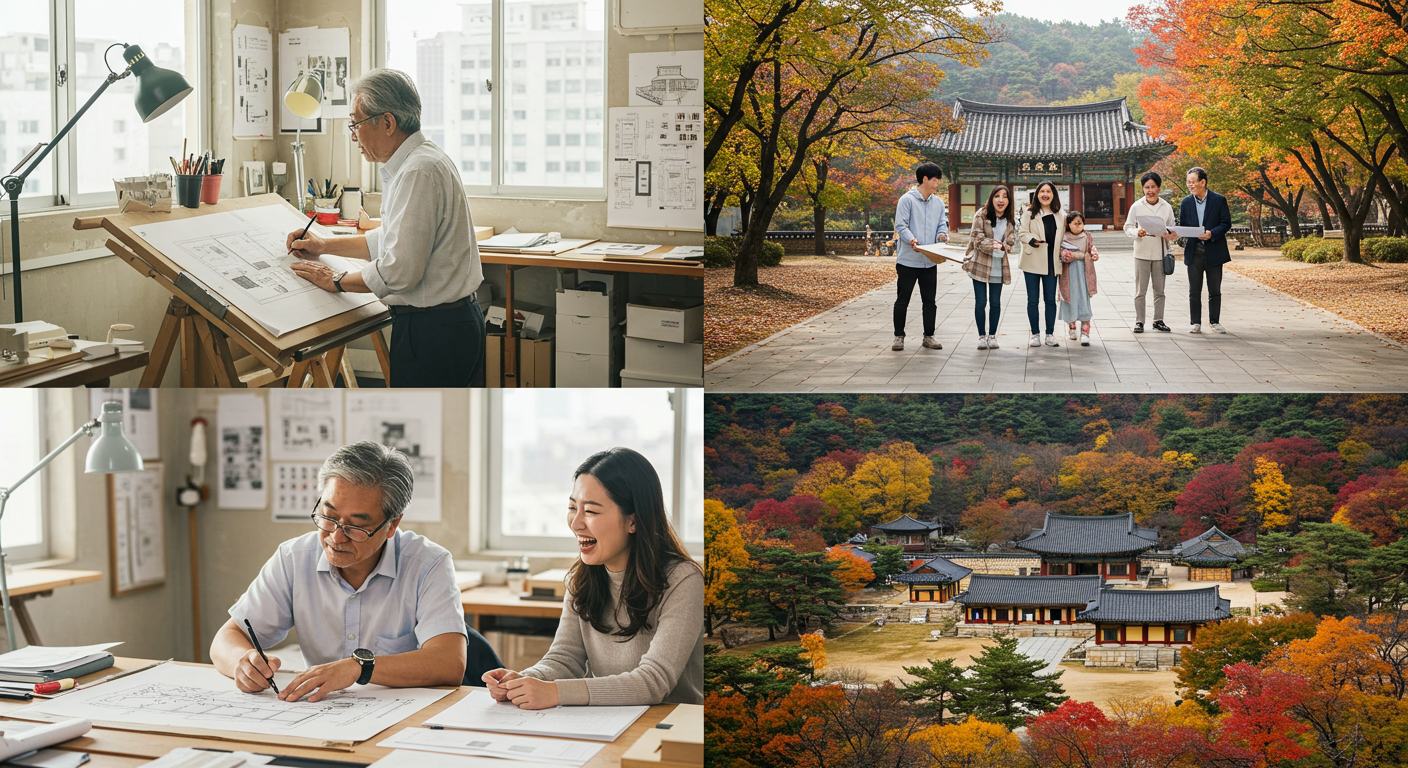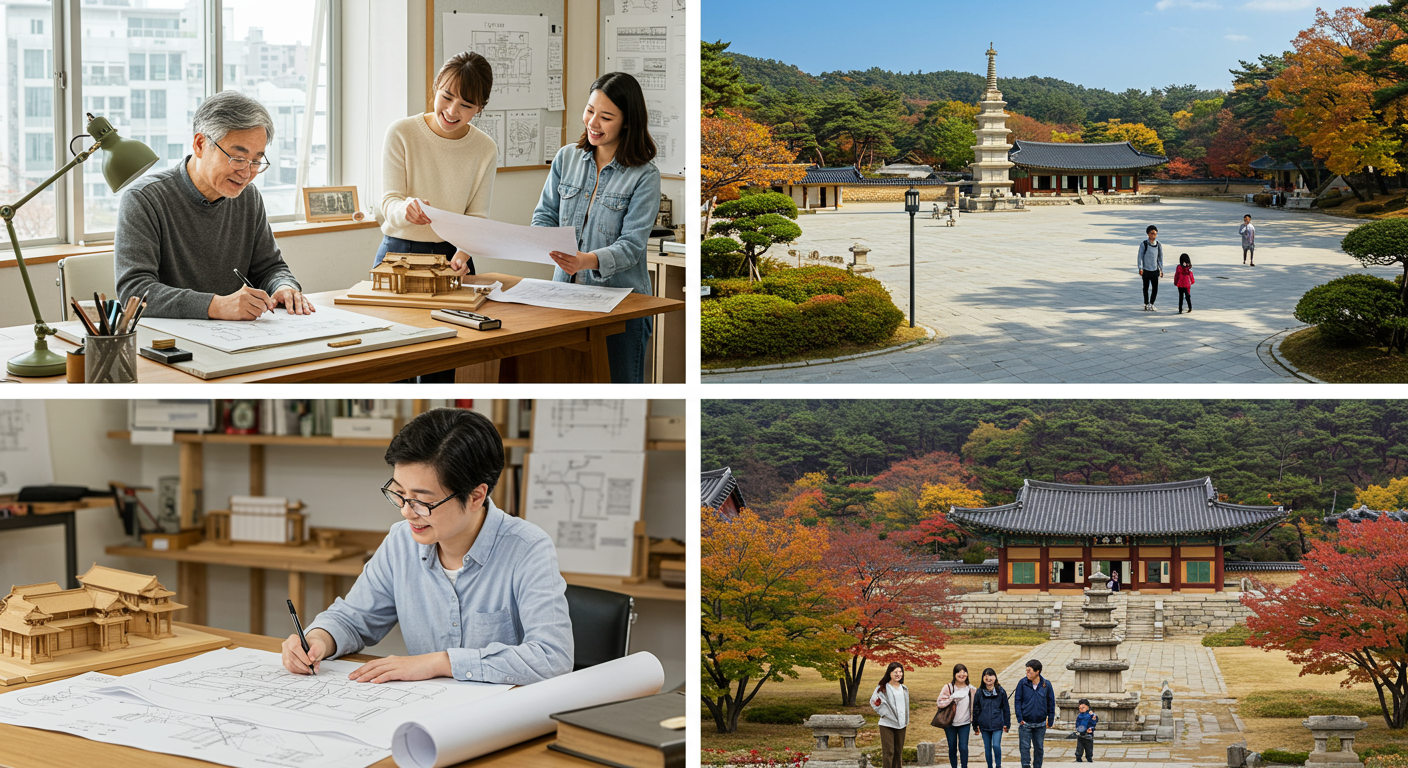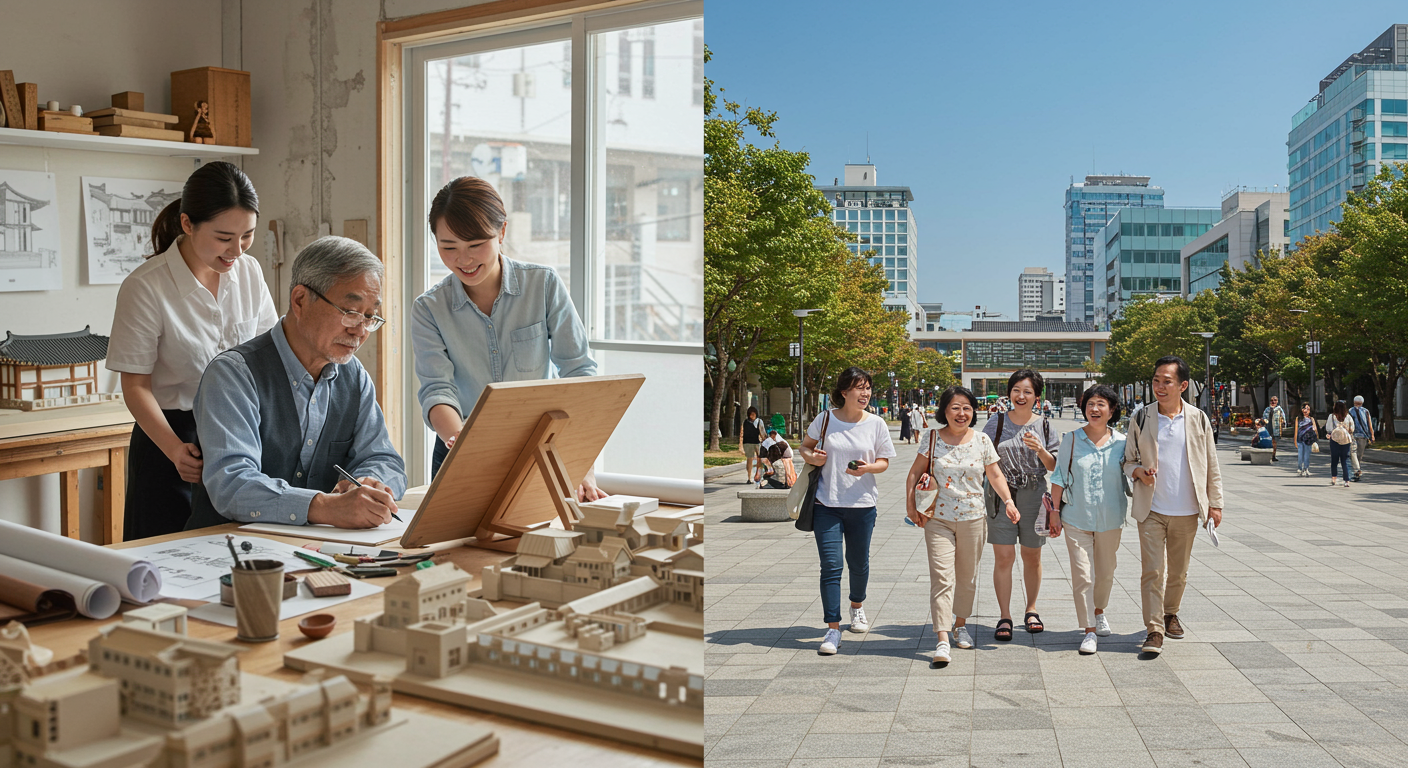Korean Architecture: Weaving Identity and Community Through Time
Korean Architecture: Weaving Identity and Community Through Time
Have you ever walked through an old city and felt its history whisper to you, or stood before a building that just *felt* like home, even if it wasn't yours?
Honestly, for me, that's the magic of Korean architecture. It’s so much more than just bricks and mortar, or wood and tile. It’s a living story, a reflection of a culture that truly cherishes harmony, identity, and that wonderful collective spirit we call community. Today, I want us to take a little journey, exploring how these incredible structures—from ancient temples to modern marvels—don’t just stand, they *speak*, shaping who Koreans are and how they connect with each other and their beautiful land. It’s a blend of nature, community, and a timeless beauty that just captures your heart.
목차
Unveiling the Soul of Korean Architecture
Korean architecture, for me, has this really distinctive charm. It’s not just about the impressive temples or the quaint traditional houses; it’s about a profound philosophical depth that connects every structure to its environment. When you look at a traditional Korean building, you immediately sense a dialogue between human ingenuity and the surrounding nature. It’s like the architects knew exactly how to make their creations belong, rather than just stand out. They weren't just building structures, you know? They were crafting spaces that would become part of the land, part of people's lives. It truly embodies a way of living, a profound respect for both people and planet.
 Description : "An older Korean architect, with thoughtful expression, sketching traditional Hanok designs in a sunlit studio, surrounded by architectural models. Realistic photo style."
Description : "An older Korean architect, with thoughtful expression, sketching traditional Hanok designs in a sunlit studio, surrounded by architectural models. Realistic photo style."
Building Identity: The Philosophy Behind Traditional Korean Homes
The *Hanok*, our traditional Korean house, is probably the best example of how our architecture embodies core Korean values. These aren't just pretty houses; they're designed with a whole philosophy in mind. Think about the *ondol*—our unique underfloor heating system—and the *maru*, a raised wooden floor. They aren't just features; they represent how Koreans interact with their environment and each other. The *ondol* keeps you warm in winter, drawing you closer to the earth, while the *maru* offers a cool, breezy space in summer, opening you up to nature. It’s truly fascinating, this balance they strike.
Harmony with Nature (Baesanimsu)
One of the most striking things about traditional Korean architecture is its absolute devotion to nature. We call it *Baesanimsu* (배산임수), meaning 'backed by mountains, fronted by water'. It's not just a design principle; it's a way of life, truly. Buildings are always, *always* situated to embrace the natural environment, using locally sourced materials like wood, earth, and stone. My honest take? It's like the buildings *breathe* with the landscape, perfectly nestled in their surroundings rather than trying to dominate them. It creates such a serene, integrated feeling.
Simplicity and Functionality
Beyond nature, there’s an understated elegance to Korean design. We’re not about flashy ornamentation or excessive decoration. Instead, the focus is squarely on simplicity and functionality, ensuring durability and practicality above all else. It's about a quiet strength, if you ask me. Every element, every beam, every window has a purpose. This isn't to say it's boring, quite the opposite! It allows the natural beauty of the materials and the surrounding environment to shine through, creating an aesthetic that feels both profound and incredibly livable.
Beyond Walls: How Architecture Fosters Community
You know, it’s not just the individual buildings that impress me; it’s how Korean architectural design, especially in traditional settings, inherently facilitates social interaction and community bonding. From the shared courtyards of *Hanok* homes to the carefully planned layouts of ancient villages, everything feels designed to bring people together. Temples, palaces, and even marketplaces weren't just functional spaces; they were vibrant hubs where life unfolded, stories were shared, and community ties were strengthened. It's a wonderful example of how architecture can truly build relationships, not just structures.
To illustrate how these spaces have evolved, let's look at some examples of traditional and modern community spaces in Korea:
| Space Type | Traditional Role | Modern Equivalent/Role |
|---|---|---|
| Hanok Courtyard | Family gatherings, neighborhood interactions | Community Centers, Shared co-working spaces |
| Buddhist Temples & Confucian Academies | Spiritual guidance, scholarly exchange, social support | Public Parks, Cultural Complexes, Libraries |
| Village Marketplaces | Trade, social hubs, information exchange | Modern Shopping Streets, Online Forums |
 Description : "A diverse group of people, young and old, enjoying a vibrant modern public plaza in a Korean city, with traditional elements subtly integrated into the design. Bright, energetic photo style."
Description : "A diverse group of people, young and old, enjoying a vibrant modern public plaza in a Korean city, with traditional elements subtly integrated into the design. Bright, energetic photo style."
Gyeongju: A Living Tapestry of Ancient Design
If you really want to dive deep into Korean architectural history, you *have* to visit Gyeongju. It’s not just a city; it's a living museum, often called "the city of a thousand years." Honestly, stepping into Gyeongju feels like you've been transported back in time. The entire city is a testament to the Silla Kingdom's incredible artistry and vision, showcasing how beautifully architecture can preserve heritage and tell stories through the ages. It's truly a beacon of traditional Korean design.
Bulguksa Temple and Seokguram Grotto: Pinnacles of Silla Artistry
When I first saw Bulguksa Temple, I was utterly mesmerized. It’s a UNESCO World Heritage site, and for good reason! The grandeur of its wooden halls, the intricate stone pagodas like Dabotap and Seokgatap, and the sheer scale of the complex speak volumes about Silla's architectural genius. And then there's Seokguram Grotto, nestled high on a mountain. The serenity you feel inside, facing that majestic stone Buddha, is just profound. It's a perfect blend of spiritual significance and incredible engineering.
Hanok Villages and Royal Tombs: Echoes of a Golden Age
Beyond the grand temples, Gyeongju offers charming *Hanok* villages, where you can wander through traditional homes and really get a feel for daily life centuries ago. It’s a stark yet beautiful contrast to the majestic royal tombs, like those found in Daereungwon. These enormous grass-covered mounds, housing the Silla kings and queens, are truly unique grave sites. The whole city is this incredible seamless blend of residential areas, spiritual centers, and historical grandeur.
If you're planning a trip to Gyeongju, here are some must-do activities to immerse yourself in its architectural wonders:
- Wander through the ancient grounds of Bulguksa Temple, feeling the centuries of devotion in every stone and beam.
- Experience the profound tranquility of Seokguram Grotto's magnificent stone Buddha, a true masterpiece.
- Stroll through charming *Hanok* villages like Gyerim, imagining daily life centuries ago.
- Marvel at the imposing Royal Tombs in Daereungwon, truly unique and awe-inspiring burial sites.
- Catch the evening light at Anapji Pond for a magical, reflective moment as the ancient palace ruins illuminate.
 Description : "A serene aerial view of Bulguksa Temple in Gyeongju during autumn, with colorful foliage surrounding its ancient stone pagodas and wooden halls. Majestic, sweeping photo style."
Description : "A serene aerial view of Bulguksa Temple in Gyeongju during autumn, with colorful foliage surrounding its ancient stone pagodas and wooden halls. Majestic, sweeping photo style."
Embracing the Future: Modern Korean Architecture
It’s not just about the past, though! Contemporary Korean architects are doing some truly incredible work, constantly trying to marry tradition with innovation. They’re creating unique modern aesthetics that somehow manage to feel both cutting-edge and deeply rooted in our heritage. It’s a delicate balance, but when it’s done right, it’s absolutely breathtaking. You can see this evolution everywhere, from the bustling streets of Seoul to quieter corners of the country.
Blending Old and New: A Harmonious Evolution
Walk around Seoul, and you’ll find so many examples of modern buildings that subtly incorporate traditional elements. Maybe it’s a modern high-rise with a roofline that echoes a *Hanok*, or a contemporary gallery using natural wood and stone in innovative ways. Architects are pulling inspiration from traditional spatial concepts, like the open courtyard, and reinterpreting them for today’s urban environment. It's not about imitation, but about genuine integration, creating a harmonious evolution of our architectural identity.
Sustainable Design and Urban Planning
Beyond aesthetics, there’s a growing focus on sustainable design and urban planning. Korean architects are increasingly looking at eco-friendly practices, trying to balance modern needs with environmental responsibility. It’s not just about constructing pretty buildings anymore; it’s about creating livable, sustainable cities that respect both history and the natural world. This focus on long-term impact and thoughtful development is, I think, a truly exciting direction for the future of Korean architecture. It’s about building for the next thousand years, just like our ancestors did.
So, there you have it. Korean architecture, in all its forms, is this incredible, living art form. It's not just about the buildings themselves, but about the stories they tell, the communities they foster, and the identity they help to shape. From the ancient, serene temples of Gyeongju to the bold, innovative designs of modern Seoul, each structure reflects a deep respect for harmony – between people, between nature, and between past and future. It's a journey through history, philosophy, and an unwavering spirit of connection. I truly hope this little exploration has inspired you as much as it inspires me every day.
If you ever get the chance, I urge you to visit Korea and experience these architectural wonders for yourself. And please, share your favorite Korean architectural experiences, or any thoughts you have, in the comments below! I'd love to hear from you.
Your Questions About Korean Architecture, Answered
Well, I think it's the strong emphasis on harmonious integration with nature, often following a "back to mountains, front to water" (Baesanimsu) principle. Plus, the unique heating system (*ondol*) and the wooden floor structure (*maru*) of the *Hanok* really set it apart. There's a certain understated elegance and practicality, too, which I find captivating.
Absolutely, you totally can! Seoul has beautifully preserved palaces like Gyeongbokgung (경복궁) and Changdeokgung (창덕궁), along with charming *Hanok* villages such as Bukchon (북촌) and Namsangol (남산골). And honestly, Gyeongju (경주) is an absolute must-visit for its rich historical sites. You can even find places to stay overnight in a *Hanok* for a truly immersive experience!
Oh, absolutely! Many contemporary Korean architects are really inspired by traditional elements. You’ll definitely find modern high-rises with subtle Korean rooflines, or buildings that innovatively use traditional materials like wood and stone. It’s honestly a beautiful blend of past and present, creating spaces that feel both fresh and deeply rooted in our culture. It’s one of my favorite things to spot when I’m out walking around!
Comments
Post a Comment